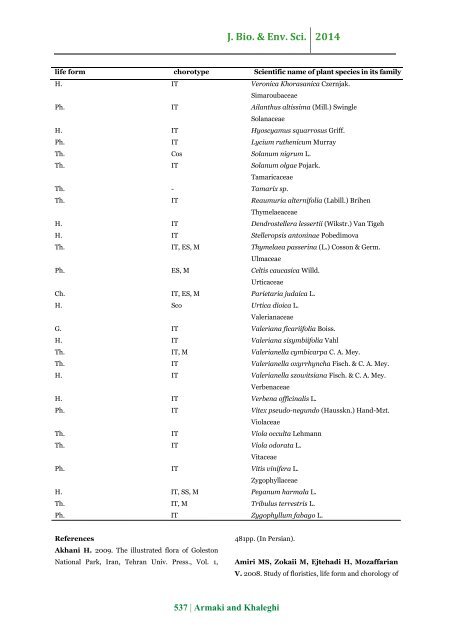Presentation of flora, life forms and chorology of rural range plants in the North East Azarbaijan province, Iran
Abstract Floristic studies are fundamental for the applied sciences such as rangeland management and conservation. Unique ecological and climatic conditions in the North East Azarbaijan Province (NAP) make it a remarkable habitat for the floristic studies. Plant species were collected from 50 field sites, representing major habitats of winter and rural rangelands. Surveys were conducted during active growth periods in 2012 and 2013. Plant species were identified and their chorology and life form determined through laboratory examinations and by using reference books. Floristic surveys resulted in identification of 534 plant species, belonged to 315 genus and 68 families. Asteraceae, Poaceae and Fabaceae were respectively the most abundant plant families. Among the life forms, Hemicryptophytes, Therophytes, Chamaephytes, Phanerophytes and Geophytes included 45, 32, 9, 7 and 7% of the total species, respectively. Irano-Turanian was the most dominant (65%) Chorotypes. The dominance of Hemicryptophytes and Therophytes, as well as vast distribution of Chamaephytes, can be referred to the simultaneous effects of climate fluctuations and livestock grazing on the flora of winter and rural rangelands in NAP.
Abstract
Floristic studies are fundamental for the applied sciences such as rangeland management and conservation. Unique ecological and climatic conditions in the North East Azarbaijan Province (NAP) make it a remarkable habitat for the floristic studies. Plant species were collected from 50 field sites, representing major habitats of winter and rural rangelands. Surveys were conducted during active growth periods in 2012 and 2013. Plant species were identified and their chorology and life form determined through laboratory examinations and by using reference books. Floristic surveys resulted in identification of 534 plant species, belonged to 315 genus and 68 families. Asteraceae, Poaceae and Fabaceae were respectively the most abundant plant families. Among the life forms, Hemicryptophytes, Therophytes, Chamaephytes, Phanerophytes and Geophytes included 45, 32, 9, 7 and 7% of the total species, respectively. Irano-Turanian was the most dominant (65%) Chorotypes. The dominance of Hemicryptophytes and Therophytes, as well as vast distribution of Chamaephytes, can be referred to the simultaneous effects of climate fluctuations and livestock grazing on the flora of winter and rural rangelands in NAP.
You also want an ePaper? Increase the reach of your titles
YUMPU automatically turns print PDFs into web optimized ePapers that Google loves.
J. Bio. & Env. Sci. 2014<br />
<strong>life</strong> form chorotype Scientific name <strong>of</strong> plant species <strong>in</strong> its family<br />
H. IT Veronica Khorasanica Czernjak.<br />
Simaroubaceae<br />
Ph. IT Ailanthus altissima (Mill.) Sw<strong>in</strong>gle<br />
Solanaceae<br />
H. IT Hyoscyamus squarrosus Griff.<br />
Ph. IT Lycium ru<strong>the</strong>nicum Murray<br />
Th. Cos Solanum nigrum L.<br />
Th. IT Solanum olgae Pojark.<br />
Tamaricaceae<br />
Th. - Tamarix sp.<br />
Th. IT Reaumuria alternifolia (Labill.) Brihen<br />
Thymelaeaceae<br />
H. IT Dendrostellera lessertii (Wikstr.) Van Tigeh<br />
H. IT Stelleropsis anton<strong>in</strong>ae Pobedimova<br />
Th. IT, ES, M Thymelaea passer<strong>in</strong>a (L.) Cosson & Germ.<br />
Ulmaceae<br />
Ph. ES, M Celtis caucasica Willd.<br />
Urticaceae<br />
Ch. IT, ES, M Parietaria judaica L.<br />
H. Sco Urtica dioica L.<br />
Valerianaceae<br />
G. IT Valeriana ficariifolia Boiss.<br />
H. IT Valeriana sisymbiifolia Vahl<br />
Th. IT, M Valerianella cymbicarpa C. A. Mey.<br />
Th. IT Valerianella oxyrrhyncha Fisch. & C. A. Mey.<br />
H. IT Valerianella szowitsiana Fisch. & C. A. Mey.<br />
Verbenaceae<br />
H. IT Verbena <strong>of</strong>fic<strong>in</strong>alis L.<br />
Ph. IT Vitex pseudo-negundo (Hausskn.) H<strong>and</strong>-Mzt.<br />
Violaceae<br />
Th. IT Viola occulta Lehmann<br />
Th. IT Viola odorata L.<br />
Vitaceae<br />
Ph. IT Vitis v<strong>in</strong>ifera L.<br />
Zygophyllaceae<br />
H. IT, SS, M Peganum harmala L.<br />
Th. IT, M Tribulus terrestris L.<br />
Ph. IT Zygophyllum fabago L.<br />
References<br />
Akhani H. 2009. The illustrated <strong>flora</strong> <strong>of</strong> Goleston<br />
National Park, <strong>Iran</strong>, Tehran Univ. Press., V0l. 1,<br />
481pp. (In Persian).<br />
Amiri MS, Zokaii M, Ejtehadi H, Mozaffarian<br />
V. 2008. Study <strong>of</strong> floristics, <strong>life</strong> form <strong>and</strong> <strong>chorology</strong> <strong>of</strong><br />
537 | Armaki <strong>and</strong> Khaleghi





![Review on: impact of seed rates and method of sowing on yield and yield related traits of Teff [Eragrostis teff (Zucc.) Trotter] | IJAAR @yumpu](https://documents.yumpu.com/000/066/025/853/c0a2f1eefa2ed71422e741fbc2b37a5fd6200cb1/6b7767675149533469736965546e4c6a4e57325054773d3d/4f6e6531383245617a537a49397878747846574858513d3d.jpg?AWSAccessKeyId=AKIAICNEWSPSEKTJ5M3Q&Expires=1716375600&Signature=5uDE7VTz%2FVM6AAeVXJHWfAVdJp8%3D)












